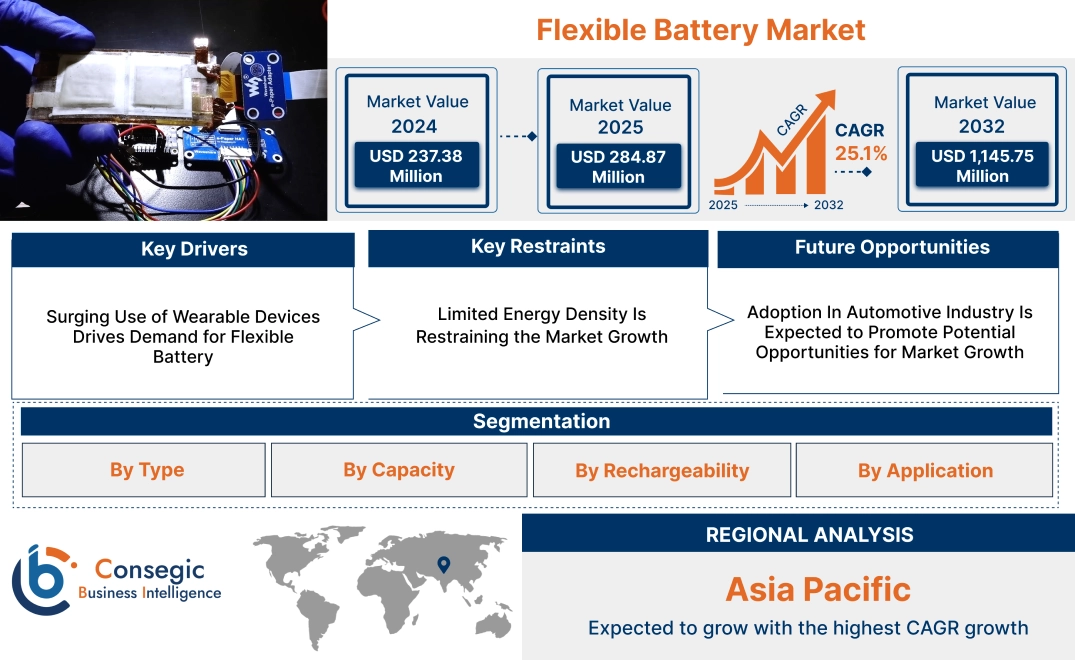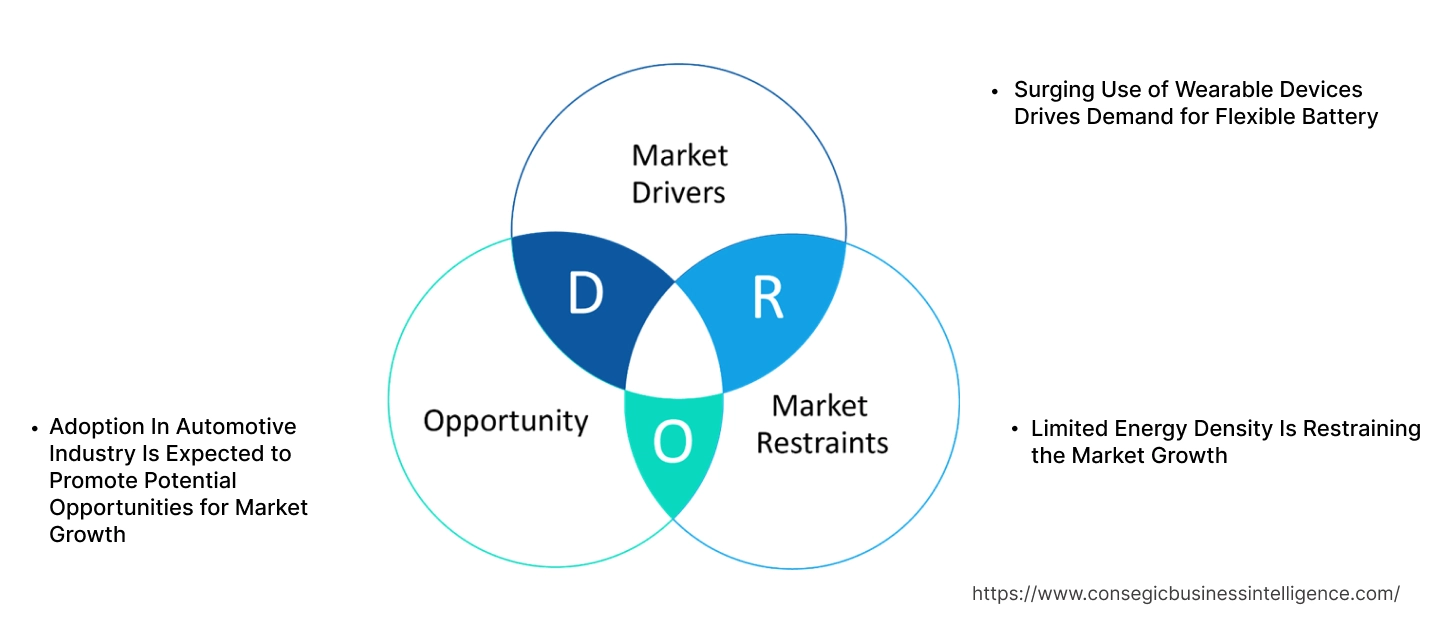Flexible Battery Market Scope & Overview:
Flexible batteries refer to batteries which have characteristics such as foldability and twist, as well as maintain characteristic shape even when continuously bent or twisted. Moreover, the key benefits include ultra-thin, eco-friendly, lightweight, portability, enhanced safety, extended battery life and more driving the flexible battery market growth.
Additionally, the batteries are majorly utilized in applications such as consumer electronics, smart packaging, smart cards, and others. Further, the rising adoption of IoT embedded smart devices is driving the flexible battery market growth.
Flexible Battery Market Size:
Flexible Battery Market is estimated to reach over USD 1,145.75 Million by 2032 from a value of USD 237.38 Million in 2024 and is projected to grow by USD 284.87 Million in 2025, growing at a CAGR of 25.1% from 2025 to 2032.
Flexible Battery Market Dynamics - (DRO) :
Key Drivers:
Surging Use of Wearable Devices Drives Demand for Flexible Battery
The rising adoption of wearable devices such as fitness band, smartwatches, and smart glasses, among other utilizes flexible rechargeable battery which in turn is driving the flexible battery market demand. Additionally, factors including longer battery life and compact design with wireless changing capabilities are primary aspects fostering the adoption of wearable devices. Furthermore, the changing design aspect of wearable devices is driving the adoption of flexible batteries which in turn is boosting market progress.
- For instance, According to IBEF, India’s wearable market recorded a growth of 34 YoY with the shipping of 134 million units in CY 2023 driving the evolution of wearable devices which in turn is boosting the market progress.
Therefore, the changing design aspect of wearable devices and rising adoption of wearable devices is driving the growth of the market.
Key Restraints:
Limited Energy Density Is Restraining the Market Growth
Energy density refers to the capacity of battery to store per unit volume which determines the longevity of operation and limited energy density leads to shorter periodic operations hindering the flexible battery market expansion. Also, the thin and compact design limits the capacity of battery as well as miniaturization of devices limits the energy density which in turn restricts the flexible battery market expansion.
Therefore, the thin and compact size of devices is limiting the battery capacity which leads to shorter operating time in turn restraining the market growth.
Future Opportunities :
Adoption In Automotive Industry Is Expected to Promote Potential Opportunities for Market Growth
The increasing adoption of electric vehicles is propelling battery manufacturers to develop advanced energy storage systems. Also, electric and hybrid vehicles require lightweight and high density batteries which in turn drive flexible battery market opportunities. Additionally, the rising adoption of smart infotainment system, OLED displays, smart dashboards, smart lighting, and others propel the market adoption.
Further, the integrating automotive sensors and IoT devices such as tire pressure sensors, ADAS, and air quality sensors, among others require batteries which in turn is boosting the flexible battery market opportunities. Furthermore, the rising adoption of electric buses, electric trucks and other heavy automotive vehicles is paving the way for market progress.
- For instance, in June 2023, Forsee Power launched Flex Plus, which is an eco-designed flexible battery system for heavy vehicles such as bus and trucks. Also, the battery system has 52 kWh, and 56 kWh capacity designed for thermal hybrid application or fuel cell hydrogen vehicles.
Hence, the rising adoption of electric vehicles and hybrid vehicles as well as integrating automotive sensors and IoT devices and rising adoption of electric buses, electric trucks and other heavy automotive vehicles is anticipated to boost market during the forecast period.
Top Key Players and Market Share Insights:
The global flexible battery market is highly competitive with major players providing flexible batteries to the national and international markets. Key players are adopting several strategies in research and development (R&D), product innovation, and end-user launches to hold a strong position in the flexible battery industry. Key players in the flexible battery market include-
- BENZO Energy technology Co.,Ltd (China)
- LiBEST Inc. (Republic of Korea)
- Imprint Energy (USA)
- Energy Diagnostics (UK)
- Ultralife Corporation (USA)
- LG Energy Solution Europe GmbH. (Germany)
- Panasonic Corporation (Japan)
- Samsung (South Korea)
- Molex (USA)
- Enfucell (Finland)
Flexible Battery Market Segmental Analysis :
By Type:
Based on the type, the market is bifurcated into printed battery and thin-film battery.
Trends in the Type:
- The trend towards adoption of sustainable and eco-friendly devise in smart packaging and medical sector is driving the need for printed batteries.
- The trend towards rising adoption of RFID tags in the retail industry is driving the progress of thin film battery segment.
The thin film battery accounted for the largest revenue share in the year 2024 and is anticipated to register the fastest CAGR during the forecast period.
- The thin film batteries are expanding the adoption from consumer electronics sector to healthcare sector by driving the adoption of implantable devices and wearable medical devices.
- Furter, the rising demand for lightweight wearable devices is driving the development of thin film battery segment in turn fuels the flexible battery market size.
- Furthermore, the expanding IoT connected devices is driving the need for thin film batteries which in turn is boosting the flexible battery market share.
- For instance, Molex is a leading manufacturer of thin film battery featuring reduced internal resistance, increased peak current, increased usable capacity and reduced footprint among others.
- Thus, according to the flexible battery market analysis, the expanding IoT connected devices and rising need for lightweight wearable devices is driving the thin film battery segment progress.
By Capacity:
Based on the capacity, the market is segmented into below 10 mAh, 10 mAh to 100 mAh and above 100 mAh.
Trends in the Capacity:
- The rising adoption of RFID in smart packaging is driving the adoption of below 10 mAh battery capacity which in turn is boosting the flexible battery market trend.
- Portable medical devices require reliable battery solutions during emergencies are driving the adoption of above 100 mAh battery capacity which in turn is fueling the flexible battery market trend.
The 10 mAh to 100 mAh accounted for the largest revenue share of 52.21% in the year 2024.
- The expanding IoT applications such as smart home appliances, monitoring system, HVAC system, thermostats and others are boosting the development of flexible battery industry.
- Further, the rising adoption of wearable technology such as fitness trackers, smartwatches, health monitoring devices and others adopted 10 mAh to 100 mAh batteries which in turn boost the flexible battery market size.
- Furthermore, the emergence of smart cards and medical devices is driving the adoption of battery with 10 mAh to 100 mAh capacity which in turn is driving the flexible battery market share.
- For instance, LiBEST based out in China is a leading manufacturer of flexible battery with 138 mAh battery capacity which is designed for application such as rings, smartwatch, neck band, AR and VR glasses among others.
- Thus, according to the flexible battery market analysis, emergence of smart cards and medical devices as well as rising adoption of wearable technology is driving the adoption of 10 mAh to 100 mAh segment.
The above 100 mAh is anticipated to register the fastest CAGR during the forecast period.
- The expanding adoption in the electric vehicles for integrating sensors, IoT connected devices requiring higher battery capacity for operating for longer time is driving the adoption of above 100 mAh battery capacity.
- Further, the advancing emerging technologies such as AR and VR glasses and advanced health monitoring devices require higher battery capacity which in turn is driving the above 100 mAh battery segment.
- Furthermore, the rise of foldable and expandable smartphones is driving the adoption of flexible batteries with above 100 mAh batteries.
- Therefore, as per the market analysis, the advancing emerging technologies such as AR and VR glasses and advanced health monitoring devices are anticipated to boost the flexible battery market demand during the forecast period.
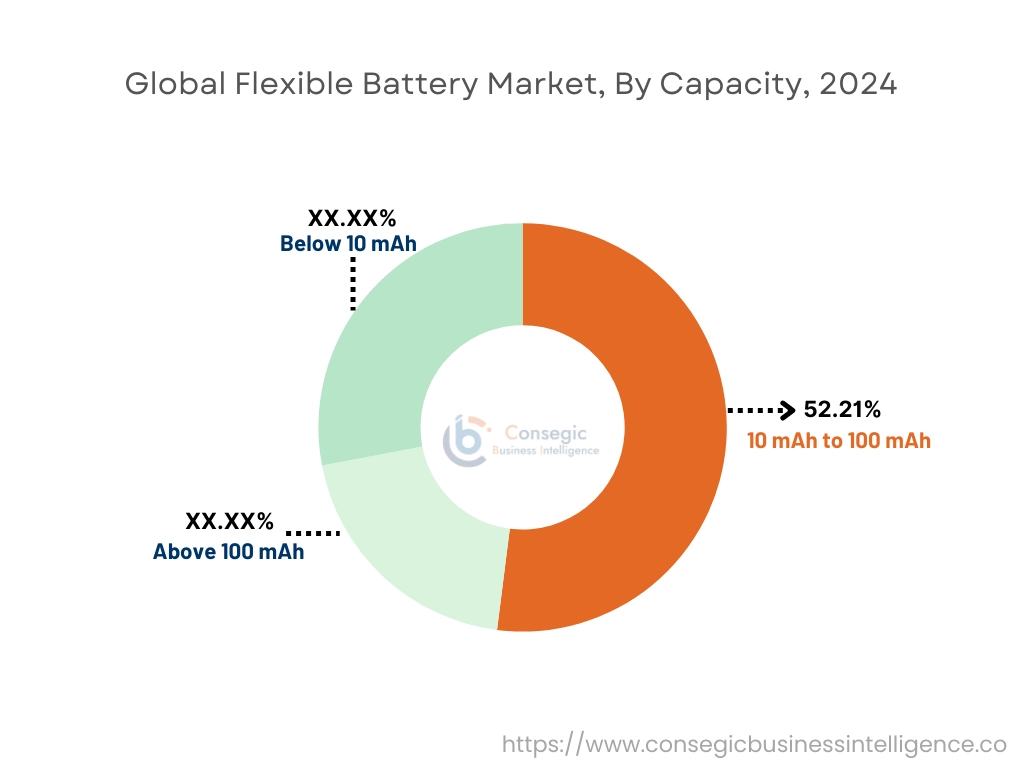
By Rechargeability:
Based on the rechargeability, the market is bifurcated into single use battery and chargeable battery.
Trends in the Rechargeability:
- The trend towards development of sustainable and eco-friendly batteries is driving the technological advancement in single use batteries.
- The trend towards rising adoption of various medical devices is driving the adoption of single use batteries.
The chargeable battery accounted for the largest revenue share in the year 2024 and is anticipated to register the fastest CAGR during the forecast period.
- Chargeable batteries reduce costs significantly by minimizing the need for battery replacement in turn is driving the chargeable battery segment progress.
- Further, the emergence of AR and VR glass technology is driving the adoption of chargeable batteries which in turn enhance the user experience is driving the chargeable segment progress.
- Furthermore, chargeable batteries are wily used in smartwatches, fitness trackers and health monitoring devices in turn driving the adoption of flexible chargeable batteries.
- For instance, in December 2022, LiBEST partnered with Mand.ro to launched flexible rechargeable batteries for application in metaverse devices and electronic prosthetic arm.
- Thus, as per the market analysis, the emergence of AR and VR glass technology and rising adoption in smartwatches, fitness trackers and health monitoring devices are driving the chargeable batteries segment progress.
By Application:
Based on the application, the market is segmented into consumer electronics, medical devices, smart packaging, automotive, smart cards, and others.
Trends in the Application:
- The trend towards miniaturization of electronics devices and appliances is driving the demand for flexible batteries in the consumer electronics sector.
- The trend towards adoption of RFID, smart cards and others integrated with flexible batteries is driving the market progress.
Consumer electronics accounted for the largest revenue share in the year 2024 and is anticipated to register the fastest CAGR during the forecast period.
- IoT connected devices are emerging in the consumer electronics sector which is driving the adoption of smart home appliances which in turn is boosting the flexible batteries market progress.
- Moreover, the advancing compact design and shape of electronic devices is driving the adoption of flexible batteries in the consumer electronics sector.
- Further, the growing adoption of smartphones, smart watches, fitness trackers and health monitoring devices are driving the progress of consumer electronics sector which in turn is boosting the market progress.
- For instance, according to IBEF, India is the second largest manufacturer of mobile and India exported mobile phones worth USD 5.45 Billion in 2021-22 and USD 11.12 Billion in 2022-23 in turn driving the adoption of battery in the market.
- Thus, as per the market analysis, growing adoption of smartphones, smart watches, fitness trackers and health monitoring devices is driving the adoption of flexible batteries in consumer electronics sector.
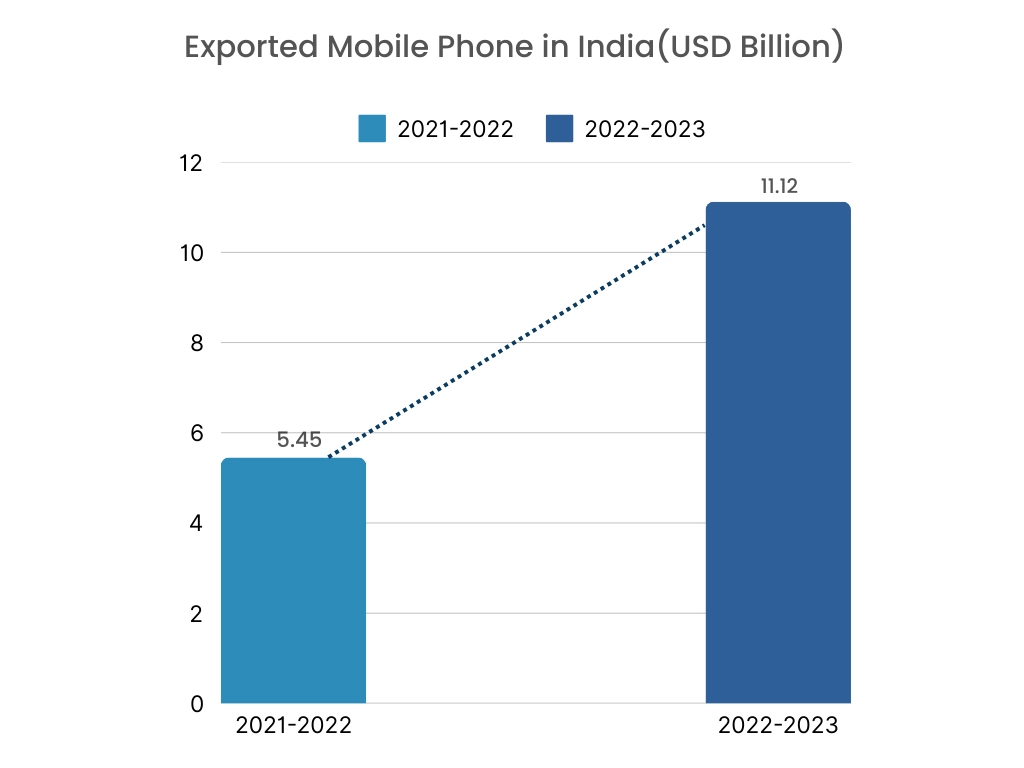
Flexible Battery Market Report Insights :
| Report Attributes | Report Details |
| Study Timeline | 2019-2032 |
| Market Size in 2032 | USD 1,145.75 Million |
| CAGR (2025-2032) | 25.1% |
| By Type |
|
| By Capacity |
|
| By Rechargeability |
|
| By Application |
|
| By Region |
|
| Key Players |
|
| North America | U.S. Canada Mexico |
| Europe | U.K. Germany France Spain Italy Russia Benelux Rest of Europe |
| APAC | China South Korea Japan India Australia ASEAN Rest of Asia-Pacific |
| Middle East and Africa | GCC Turkey South Africa Rest of MEA |
| LATAM | Brazil Argentina Chile Rest of LATAM |
| Report Coverage |
|
Regional Analysis:
The regions covered are North America, Europe, Asia Pacific, Middle East and Africa, and Latin America.

Asia Pacific region was valued at USD 65.21 Million in 2024. Moreover, it is projected to grow by USD 78.62 Million in 2025 and reach over USD 332.27 Million by 2032. Out of this, China accounted for the maximum revenue share of 35.2%. The market progress for flexible batteries is mainly driven by deployment in consumer electronics and automotive industries, among others. Furthermore, factors including rising adoption of wearable devices and integration of flexible batteries into emerging electric vehicles is projected to drive the market progress during the forecast period.
- For instance, according to IBEF, India’s smartwatch shipments in FY23, rise by 50% YoY which is driven by the rising penetration and proliferation of low-cost devices to customers.
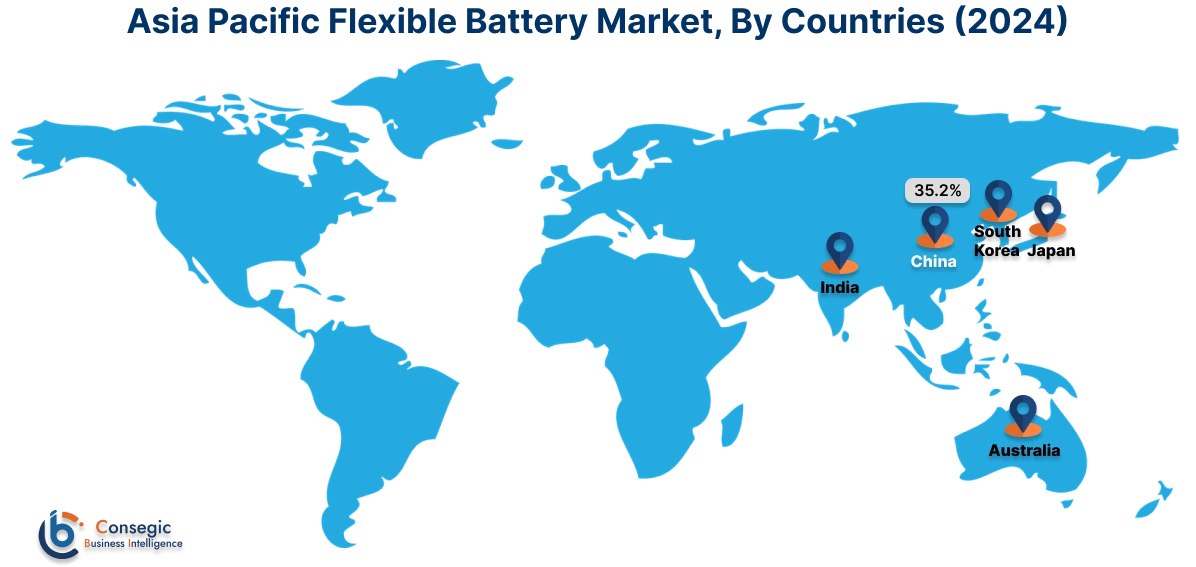
North America is estimated to reach over USD 446.84 Million by 2032 from a value of USD 93.06 Million in 2024 and is projected to grow by USD 111.63 Million in 2025. The North American region's growing advancement in the medical devices offer lucrative growth prospects for the market. Additionally, the rising adoption of wearable devices is driving the market progress.
- For instance, in May 2024, Accelera launched cutting-edge decarbonizing technologies including BP104E which is flexible battery platform. The battery features a superior life performance and fast charging capabilities.
The regional evaluation depicts that the rising adoption in renewable energy integration and automotive sector is driving the market in Europe. Additionally, the key prospect driving the market is increasing government support towards adoption of advanced technologies in the Middle East and African region. Further, the rising consumer electronics sector is paving the way for the progress of market in Latin America region.
Recent Industry Developments :
Partnerships & Collaborations:
- In August 2023, Honeywell partnered with Nuvation energy to add flexible battery management system to Honeywell ionic. The aim of the partnership is to offer a cost-competitive and reliable solution for commercial and industrial customers.
Key Questions Answered in the Report
How big is the flexible battery market? +
The Flexible Battery Market is estimated to reach over USD 1,145.75 Million by 2032 from a value of USD 237.38 Million in 2024 and is projected to grow by USD 284.87 Million in 2025, growing at a CAGR of 25.1% from 2025 to 2032.
What specialized segmentation details are covered in the flexible battery report? +
The flexible battery report includes specific segmentation details for type, capacity, rechargeability, application, and regions.
Which is the fastest segment anticipated to impact the market growth? +
In the flexible battery market, the above 100 mAh is the fastest-growing segment during the forecast period due to emergence of smart cards and medical devices as well as rising adoption of wearable technology.
Who are the major players in the flexible battery market? +
The key participants in the flexible battery market are BENZO Energy technology Co., Ltd (China), LiBEST Inc. (Republic of Korea), LG Energy Solution Europe GmbH. (Germany), Panasonic Corporation (Japan), Samsung (South Korea), Molex (USA), Enfucell (Finland), Imprint Energy (USA), Energy Diagnostics (UK), Ultralife Corporation (USA) and others.
What are the key trends in the flexible battery market? +
The flexible battery market is being shaped by several key trends including trend towards miniaturization of electronics devices and development of sustainable and eco-friendly batteries are the key trends driving the market.
